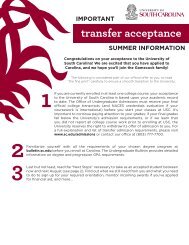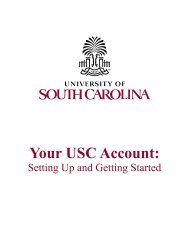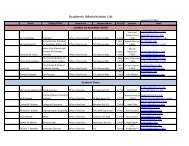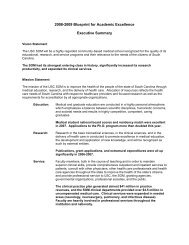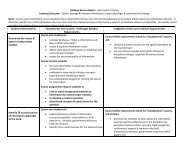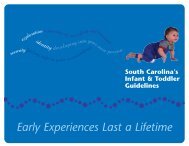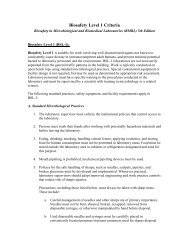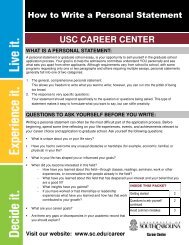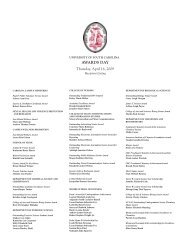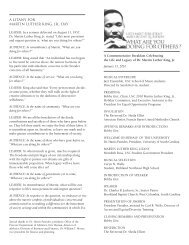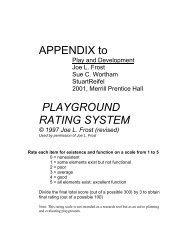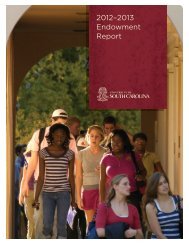FOCUS CAROLINA STRATEGIC PLAN - University of South Carolina
FOCUS CAROLINA STRATEGIC PLAN - University of South Carolina
FOCUS CAROLINA STRATEGIC PLAN - University of South Carolina
Create successful ePaper yourself
Turn your PDF publications into a flip-book with our unique Google optimized e-Paper software.
Focus <strong>Carolina</strong> Strategic Plan<br />
<strong>University</strong> <strong>of</strong> <strong>South</strong> <strong>Carolina</strong><br />
December 2011<br />
Contents<br />
2 Our Story<br />
2 Our Vision<br />
2 Our Mission<br />
3 Our Purpose<br />
4 Our Values<br />
4 Our Goals<br />
5 Our Initiatives<br />
5 Teaching and Learning<br />
7 Research, Scholarship and Creative Achievement<br />
9 Service Excellence<br />
10 Quality <strong>of</strong> Life on the <strong>University</strong> Campus<br />
13 Recognition and Visibility<br />
14 Our Focus<br />
14 Focus on Educational Quality<br />
19 Focus on Leadership<br />
20 Focus on Innovation<br />
21 Focus on Diversity<br />
22 Focus on Access<br />
23 Focus on Global Competitiveness<br />
24 Focus on Community Engagement<br />
25 Measures <strong>of</strong> Achievement<br />
1
Focus <strong>Carolina</strong> Strategic Plan<br />
<strong>University</strong> <strong>of</strong> <strong>South</strong> <strong>Carolina</strong><br />
Our Story<br />
What began in 1805 as a small college with one building in Columbia is now the Palmetto State’s<br />
Flagship <strong>University</strong> <strong>of</strong> <strong>South</strong> <strong>Carolina</strong> system, serving the state’s citizens with eight vibrant campuses.<br />
More than 33,000 <strong>of</strong> USC’s 44,557 current graduate and undergraduate students are <strong>South</strong><br />
<strong>Carolina</strong> residents, and nearly 165,000 <strong>of</strong> our 258,000 alumni live in this state. They are taxpayers,<br />
pr<strong>of</strong>essionals, parents, voters, corporate/community/civic leaders and retirees — people from all<br />
walks <strong>of</strong> life who, with their USC education, advance our state socially, economically and politically.<br />
The <strong>University</strong> <strong>of</strong> <strong>South</strong> <strong>Carolina</strong> is the Flagship <strong>University</strong> <strong>of</strong> the State <strong>of</strong> <strong>South</strong> <strong>Carolina</strong>.<br />
Our Vision<br />
The <strong>University</strong> <strong>of</strong> <strong>South</strong> <strong>Carolina</strong>, dedicated to enhancement <strong>of</strong> the quality <strong>of</strong> life for all citizens,<br />
is a premier flagship university system, nationally and internationally recognized for excellence and<br />
leadership and strives to<br />
n achieve the highest quality in all academic endeavors, making academic excellence our trademark.<br />
n lead globally in discovery, application and dissemination <strong>of</strong> knowledge; excel in creative<br />
achievement and attain recognition for world-renowned scholarship.<br />
n apply knowledge and problem solving to enhance the quality <strong>of</strong> life and sustainability for <strong>South</strong><br />
Carolinians and the nation.<br />
n model best practices as a global leader in research, education and community engagement.<br />
Our Mission<br />
The primary mission <strong>of</strong> the <strong>University</strong> <strong>of</strong> <strong>South</strong> <strong>Carolina</strong> is the education <strong>of</strong> the state’s diverse<br />
citizens through teaching, research, creative activity, and service. Founded in 1801, the <strong>University</strong><br />
<strong>of</strong> <strong>South</strong> <strong>Carolina</strong> system is the largest university in the state, serving more than 41,000 students<br />
from its flagship Columbia campus, three senior campuses (Aiken, Beaufort, and Upstate), and four<br />
regional campuses (Lancaster, Salkehatchie, Sumter, and Union).<br />
2
The <strong>University</strong> <strong>of</strong> <strong>South</strong> <strong>Carolina</strong> is a public institution <strong>of</strong>fering degree programs at the associates,<br />
bachelors, masters, and doctoral levels. Through the primary method <strong>of</strong> classroom and laboratory<br />
instruction and through a secondary method <strong>of</strong> distance education delivered by the internet,<br />
teleconference, streaming video and DVD, degree programs are <strong>of</strong>fered in the areas <strong>of</strong> liberal arts<br />
and sciences, education, engineering and computing, hospitality retail and sport management, mass<br />
communications and information studies, public health, and pr<strong>of</strong>essional programs such as law,<br />
medicine, nursing, pharmacy, and business.<br />
Recognized by the Carnegie Foundation as a top research and service institution, nationally ranked<br />
in start-up businesses, and conferring nearly 40% <strong>of</strong> all bachelors and graduate degrees awarded at<br />
public institutions in <strong>South</strong> <strong>Carolina</strong>, the <strong>University</strong> has a pr<strong>of</strong>ound, relevance, reach, and impact<br />
on the people <strong>of</strong> its state. The <strong>University</strong> <strong>of</strong> <strong>South</strong> <strong>Carolina</strong> provides all students with the highestquality<br />
education, including the knowledge, skills, and values necessary for success and responsible<br />
citizenship in a complex and changing world, through engagement in nationally and internationally<br />
ranked research, scholarship, service, and artistic creation.<br />
Approved by the <strong>University</strong> <strong>of</strong> <strong>South</strong> <strong>Carolina</strong> Board <strong>of</strong> Trustees July 23, 2010<br />
Our Purpose<br />
As a system, we educate, enrich and improve the quality <strong>of</strong> life <strong>of</strong> the state’s diverse citizenry through<br />
teaching, research, creative activity and service. We model what is possible for educational attainment<br />
throughout the nation.<br />
The <strong>University</strong> <strong>of</strong> <strong>South</strong> <strong>Carolina</strong> is a comprehensive public system <strong>of</strong> eight campuses, each <strong>of</strong> which<br />
contributes in unique ways to the overall mission <strong>of</strong> the <strong>University</strong> by<br />
n providing our students with the highest-quality education and the knowledge, skills and values<br />
necessary for success and responsible citizenship in a complex and changing world;<br />
n pursuing excellence in research, scholarship and artistic creation to ensure the highest value <strong>of</strong><br />
the education received by its students and to apply research, scholarship and artistic creation to<br />
improve the quality <strong>of</strong> life;<br />
n fostering a campus environment that promotes diversity and welcomes faculty, staff and a student<br />
body <strong>of</strong> all races, creeds and cultures as we address the needs <strong>of</strong> an increasingly diverse population<br />
and a global economy; and<br />
n connecting with and providing excellent and meaningful service to its communities, state, nation<br />
and the world.<br />
Our entire system holds academic excellence through excellent teaching and student-centered<br />
learning as paramount while the relative emphasis <strong>of</strong> research and service varies among our<br />
constituent institutions, depending upon our respective campus-specific missions.<br />
3
Our Values<br />
The <strong>University</strong> <strong>of</strong> <strong>South</strong> <strong>Carolina</strong>’s Carolinian Creed outlines our core values.<br />
n Personal and Academic Integrity<br />
n Respect for the dignity <strong>of</strong> all persons<br />
n Respect for rights and property <strong>of</strong> others<br />
n Celebration <strong>of</strong> differences in people, ideas and opinions<br />
n Concern for others, their feelings and their need for conditions which support their work<br />
and development<br />
In addition, the <strong>University</strong> builds a sense <strong>of</strong> community, and in our work we strive for the highest<br />
standards in:<br />
n leadership<br />
n sustainability<br />
n global thinking<br />
n interdisciplinary scholarship<br />
Our Goals<br />
Teaching and Learning:<br />
We will improve quality <strong>of</strong> academic programs at all levels; develop and nurture a faculty devoted to<br />
teaching excellence; and enhance the richness <strong>of</strong> the student experience in and beyond the classroom.<br />
The teaching and learning environment <strong>of</strong> the <strong>University</strong> <strong>of</strong> <strong>South</strong> <strong>Carolina</strong> will equal or surpass that<br />
<strong>of</strong> comprehensive state university systems that are deemed peer aspirants.<br />
Research, Scholarship and Creative Achievement:<br />
To be a top public university system dedicated to discovery, application, innovation and<br />
dissemination <strong>of</strong> knowledge, we will strive for excellence in creative achievement and worldrenowned<br />
scholarship and for recognition among comprehensive research institutions. With<br />
our established ranking as a Carnegie Very High Research <strong>University</strong>, we will continue to build<br />
collaborations and advance recognition <strong>of</strong> our scholarly research contributions.<br />
4
Service Excellence:<br />
As a dual Carnegie Service <strong>University</strong>, we engage the expertise and capabilities <strong>of</strong> faculty, staff and<br />
students with local, state, national and global communities. Our outreach will advance educational<br />
attainment at all levels, guide economic development and promote quality <strong>of</strong> life.<br />
Quality <strong>of</strong> Life on the <strong>University</strong> Campus:<br />
We aspire to make the multi-campus system a destination <strong>of</strong> choice for high-achieving faculty,<br />
students and staff who value, benefit from and contribute to a rich and rewarding learning and<br />
working environment where civility, ethics and collaboration create an inclusive culture <strong>of</strong> fairness<br />
and respect. The USC campus environment facilitates the highest levels <strong>of</strong> intellectual and personal<br />
achievement and establishes an academic culture that results in recruiting and retaining the highest<br />
quality faculty, students and staff who advance the <strong>University</strong>’s mission and enrich the communities<br />
where Carolinians live and work.<br />
Recognition and Visibility:<br />
We honor and value the unique contributions made by those who work, teach, study, graduate<br />
and learn at the eight campuses <strong>of</strong> our USC System. We will recognize and show appreciation for<br />
distinctive talents that advance our <strong>University</strong>.<br />
Our Initiatives<br />
Teaching and Learning:<br />
We will improve quality <strong>of</strong> academic programs at all levels; develop and nurture a faculty devoted to<br />
teaching excellence; and enhance the richness <strong>of</strong> the student experience in and beyond the classroom.<br />
The teaching and learning environment <strong>of</strong> the <strong>University</strong> <strong>of</strong> <strong>South</strong> <strong>Carolina</strong> will equal or surpass that<br />
<strong>of</strong> comprehensive state university systems that are deemed peer aspirants.<br />
Major initiatives:<br />
1. Recruit and retain a high quality and diverse student body<br />
n Increase the quality <strong>of</strong> undergraduate students by increasing the number <strong>of</strong> students in the<br />
Honors College and Capstone Program and the number <strong>of</strong> McNair and <strong>Carolina</strong> Scholars through<br />
targeted recruiting and increased fiscal support<br />
5
n Explore nonconventional metrics for assessing potential students, recognizing there is no single metric<br />
for quality, and support programs designed to recruit and retain underrepresented minority students<br />
n Facilitate targeted recruitment <strong>of</strong> academically talented international students<br />
2. Enhance student academic and social support services beyond the classroom through<br />
centralized advising, small group mentoring, supplemental instruction programs and<br />
support <strong>of</strong> distance education<br />
n Implement and support quality centralized advising services to help students develop a<br />
comprehensive educational plan that combines curricular planning with beyond the classroom<br />
experiences, experiential learning, leadership and service. This initiative will facilitate informed<br />
decision making and timely degree completion<br />
n Establish faculty to individual student or small group mentoring programs across the curricula<br />
to facilitate opportunities beyond the classroom for students to help them meaningfully apply<br />
knowledge, skills and aptitudes. Provide appropriate resources, incentives and rewards for faculty<br />
mentorship activities<br />
n Expand academic support services, including supplemental instruction, tutoring, early<br />
intervention, the Writing Center and programs for special populations<br />
n Enhance support for distributed learning<br />
3. Foster innovation and interdisciplinary collaboration in teaching (e.g. use <strong>of</strong><br />
instructional technology, enhancement <strong>of</strong> learning beyond the classroom and co-taught<br />
and cross-listed courses) by providing necessary resources and support<br />
n Increase access to information technology both in the classroom and out as guided by the<br />
Classroom Scheduling and Enhancement Committee and develop holistic methods <strong>of</strong> instruction to<br />
ensure effective teaching<br />
n Develop formal structures that encourage collaborative teaching between faculty at USC and other<br />
institutions. Create a course load structure to foster interdisciplinary and collaborative teaching that<br />
ensures such teaching is both valued and given full credit in tenure and promotion<br />
n Develop an administrative framework that promotes and encourages curricular innovation and<br />
interdisciplinary teaching including cross-listing <strong>of</strong> courses<br />
4. Create a culture <strong>of</strong> student-centered learning<br />
n Promote student-centered learning by presenting workshops including new faculty orientation,<br />
giving teaching awards, and showcasing faculty who practice student-centered learning<br />
n Support all students in making the most <strong>of</strong> their education by integrating course work with firsthand<br />
learning experiences outside <strong>of</strong> the classroom<br />
6
n Revise the required Provost teacher evaluation questions to measure teaching behaviors that<br />
exemplify student-centered learning<br />
5. Elevate the importance <strong>of</strong> quality teaching and mentoring within the <strong>University</strong> by<br />
improving classroom conditions, valuing teaching in hiring and compensation decisions, and<br />
providing faculty with support to improve their teaching skills or to develop new courses<br />
n Lower faculty-to-student ratios through the Faculty Replenishment Initiative<br />
n Place more emphasis on teaching in hiring decisions and incentivize quality teaching as demonstrated<br />
in the USC Columbia Faculty Manual requirements for promotion to the rank <strong>of</strong> pr<strong>of</strong>essor<br />
n Provide resources and financial support to faculty with a need or desire to improve their teaching<br />
skills and develop new courses or innovative teaching strategies<br />
6. Create and implement assessment systems for all programs that inform program<br />
improvement<br />
n Evaluate the assessment processes at the <strong>University</strong><br />
n Create a faculty committee to work with the Office <strong>of</strong> Institutional Assessment and Compliance to<br />
establish and maintain a framework for a <strong>University</strong>-wide program assessment process<br />
n Increase support for the Office <strong>of</strong> Institutional Assessment and Compliance as needed to assist<br />
units in establishing discipline-appropriate assessment processes and enhance assessment expertise and<br />
support in administrative positions<br />
n Provide pr<strong>of</strong>essional development for those in positions <strong>of</strong> leadership in relation to program<br />
assessment including deans, associate deans and department chairs<br />
n Integrate the use <strong>of</strong> assessment data to meet other university needs such as extramural research,<br />
other scholarship activities and faculty evaluations<br />
Research, Scholarship and Creative Achievement:<br />
To be a top public university system dedicated to discovery, application, innovation and dissemination<br />
<strong>of</strong> knowledge, we will strive for excellence in creative achievement and world-renowned scholarship<br />
and for recognition among comprehensive research institutions. With our established ranking as<br />
a Carnegie Very High Research <strong>University</strong>, we will continue to build collaborations and advance<br />
recognition <strong>of</strong> our scholarly research contributions.<br />
Major Initiatives:<br />
Advancing our status as a top-tier research university requires that we continually reevaluate our<br />
research strengths and identify areas where we can be a leader both nationally and internationally. To<br />
facilitate this, the following recommendations are presented.<br />
7
1. Develop and maintain a standing Presidential Advisory Council comprised <strong>of</strong> USC’s<br />
most qualified, active and externally visible faculty from across the <strong>University</strong>. This<br />
committee will:<br />
n Recommend improvements in the quality <strong>of</strong> our educational and research programs to achieve<br />
greater recognition and standing amongst our peer and peer aspirant universities<br />
n Identify future areas <strong>of</strong> emphasis for long-term institutional support <strong>of</strong> sponsored research,<br />
scholarship and creative achievement<br />
2. Develop programs to attract, develop and retain faculty. These include:<br />
n Creating a carefully regulated, proposal-driven hiring initiative, administered by the Provost’s<br />
Office to develop and strengthen targeted areas <strong>of</strong> research excellence<br />
n Developing a program to identify our most highly regarded faculty and provide them with the<br />
additional resources needed to pursue innovative ideas<br />
n Establishing a “Humanities Center” to foster cross-disciplinary research, scholarship and<br />
collaboration on targeted issues <strong>of</strong> contemporary interest to scholars among the humanities, arts,<br />
social sciences and sciences<br />
n Establishing new <strong>University</strong> awards that are given annually for excellence in “creative<br />
achievement”<br />
n Providing faculty with the administrative resources and seed money needed to organize small-tomedium-size<br />
conferences at USC on an annual basis<br />
3. Enhance the quality <strong>of</strong> graduate programs and the quality <strong>of</strong> life for graduate<br />
students engaged in research, scholarship and creative activities<br />
n Make graduate assistant stipends, tuition abatements and health insurance for all graduate<br />
assistants competitive with those at other comprehensive research universities to ensure our<br />
competitiveness and to advance our standing<br />
4. Provide resources and commit to developing the reputation, status and visibility <strong>of</strong><br />
the pr<strong>of</strong>essional schools<br />
5. Improve our administrative, technological and physical research infrastructure system<br />
to increase our competitiveness. For example, we must:<br />
n Develop centrally managed multi-user facilities for equipment and facilities broadly used in<br />
research and educational programs<br />
n Support the development <strong>of</strong> an intellectual property structure to grow <strong>University</strong>-industry<br />
collaborative research activities<br />
8
6. Re-examine our current budget model and implement changes that will direct more<br />
resources to research, scholarship and creative achievement<br />
Service Excellence:<br />
As a dual Carnegie Service <strong>University</strong>, we engage the expertise and capabilities <strong>of</strong> faculty, staff and<br />
students with local, state, national and global communities. Our outreach will advance educational<br />
attainment at all levels, guide economic development and promote quality <strong>of</strong> life.<br />
Major Initiatives:<br />
1. We should establish a Center for Service Learning and Community Engagement to<br />
coordinate service learning and community. Among other things, a Center would:<br />
n Serve as a “clearing house” to facilitate service learning and community service by connecting<br />
students, faculty and staff with outside people, institutions and agencies that provide service learning<br />
and community service opportunities<br />
n Enhance our interdisciplinary collaboration by bringing together academic and nonacademic units<br />
with overlapping or complementary interests in service activities<br />
n Provide guidance to inexperienced faculty and students who wish to implement service learning<br />
courses<br />
n Promote community service opportunities for “unaffiliated” students<br />
n Facilitate research associated with service learning and community service<br />
n Coordinate and expand existing university-wide service activities, such as the annual Martin<br />
Luther King day <strong>of</strong> service, and develop new projects <strong>of</strong> this type<br />
2. <strong>University</strong> leadership should send a clear message to academic units that service<br />
excellence is valued in tenure and promotion<br />
n Create ways for faculty to integrate service activities with research, publication and other scholarly<br />
activity<br />
3. High-level university representatives should expand outreach to representatives <strong>of</strong><br />
local and state government and other community leaders to identify service needs where<br />
our expertise is valuable<br />
n Commit to service excellence and identify regularly the community’s highest-priority service needs<br />
n Supplement the “grass-roots” and “lower-level” contacts between the university and non-university<br />
communities<br />
9
4. The university should identify one or several thematic areas that could serve as targets<br />
for interdisciplinary service learning and community service<br />
n Choose thematic areas such as at-risk youth, the elderly, the homeless, literacy and the environment/<br />
sustainability where we would match our university-wide expertise with community needs<br />
• Select specific interventions to address the thematic area <strong>of</strong> need and involve all disciplines whose<br />
expertise addresses the area <strong>of</strong> need<br />
5. The university should establish a “lifelong learning institute” in Columbia<br />
n Offer informal courses, lectures, field trips and other educational activities to the community,<br />
including older adults, at a nominal fee. Such programs currently exist at USC Beaufort and USC<br />
Aiken. The Bernard Osher Foundation has provided grants to fund lifelong learning institutes at 120<br />
colleges and universities, including Clemson, Furman, Coastal <strong>Carolina</strong> and USC Beaufort.<br />
6. The university should seek external funding to support service activities (including the<br />
proposed Center for Service Learning and Community Engagement).<br />
n Seek charitable donations for community-service-related projects through the Development Office<br />
n Seek other potential sources <strong>of</strong> funding such as the “Edward Kennedy Serve America Act.” School<br />
dropout crisis, health care and energy are specifically mentioned as target areas for which public service<br />
opportunities will be created with federal funding. Service learning is mentioned prominently in the<br />
legislation.<br />
Quality <strong>of</strong> Life on the <strong>University</strong> Campus:<br />
We aspire to make the multi-campus system a destination <strong>of</strong> choice for high-achieving faculty, students<br />
and staff who value, benefit from and contribute to a rich and rewarding learning and working<br />
environment where civility, ethics and collaboration create an inclusive culture <strong>of</strong> fairness and respect.<br />
The USC campus environment facilitates the highest levels <strong>of</strong> intellectual and personal achievement<br />
and establishes an academic culture that results in recruiting and retaining the highest quality faculty,<br />
students and staff who advance the <strong>University</strong>’s mission and enrich the communities where Carolinians<br />
live and work.<br />
Major Initiatives:<br />
1. Compensation<br />
Surveys <strong>of</strong> USC faculty, staff and graduate assistants consistently identify compensation as the leading<br />
quality <strong>of</strong> life issue that needs to be addressed<br />
n Establish salary and compensation goals for faculty and staff that will ensure that USC is<br />
competitive relative to our peer and peer-aspirant institutions<br />
10
n Develop effective strategies to meet our salary goals and address salary equity and compression<br />
that recognizes the productivity <strong>of</strong> longstanding faculty and staff<br />
n Establish goals for graduate stipends that will ensure USC’s graduate stipends are competitive<br />
relative to the graduate programs <strong>of</strong> our peer and peer-aspirant institutions<br />
n Monitor annually the progress we have made to meet our compensation goals<br />
2. Physical Environment/ Deferred Maintenance and Safety<br />
Faculty, staff and students identify their physical environment as important to their sense <strong>of</strong> wellbeing<br />
and ability to work effectively and live safely<br />
n Establish a plan, to begin in 2011, with a budget and a yearly timetable, to address both<br />
short-term and long-term deferred maintenance and safety issues in existing buildings, including<br />
classrooms, to be complete by the year 2030<br />
n Establish a policy <strong>of</strong> addressing future maintenance <strong>of</strong> all new construction at the time the<br />
construction is approved. Monitor and assess annually whether we have met our goals<br />
3. Benefits<br />
In our recent Quality <strong>of</strong> Life surveys <strong>of</strong> USC faculty and staff, the second most cited quality <strong>of</strong><br />
life issue is future benefits. Faculty and staff listed tuition waivers for spouse/domestic partner and<br />
dependents, preventive health care and vision care as the three categories <strong>of</strong> benefits they would like<br />
to have. In addition, surveys indicate the need for a system-wide family leave policy and domestic<br />
partner benefits for faculty, staff and graduate students<br />
n Provide graduate students with full health care benefits<br />
n Develop an action plan to enhance the above listed categories <strong>of</strong> benefits for our faculty, staff and<br />
graduate students during the next five years<br />
4. Fostering a Culture <strong>of</strong> Excellence<br />
The <strong>University</strong> <strong>of</strong> <strong>South</strong> <strong>Carolina</strong> should foster a culture <strong>of</strong> excellence in which faculty, staff<br />
and students feel respected, engaged, informed and valued and have a voice in decision-making.<br />
All members <strong>of</strong> the USC community should be held to high standards <strong>of</strong> performance and<br />
accountability. To that end we recommend the following actions:<br />
n Establish a Staff Senate to allow staff to have a voice in university governance<br />
n Coordinate a unified system <strong>of</strong> student advisement and develop a Student Bill <strong>of</strong> Rights and<br />
Responsibilities to better communicate to students and the university community the processes by<br />
which complaints and grievances may be addressed<br />
11
n Establish an Office <strong>of</strong> Internal Communications to make internal communications more effective<br />
and streamlined<br />
n Give deans, department chairs, directors and governance bodies resources to recognize and show<br />
appreciation <strong>of</strong> faculty, staff and students efforts and accomplishments<br />
n Establish a system-wide, interactive web calendar and an updated, user-friendly, web-based<br />
directory <strong>of</strong> faculty, staff and students; and immediately.<br />
n Address campus and system-wide deficiencies in technology and infrastructure that have a<br />
deleterious impact on efficiencies, costs and internal communication<br />
5. Diversity<br />
The Quality <strong>of</strong> Life Committee recommends that the <strong>University</strong>:<br />
n Increase the level <strong>of</strong> faculty, staff and student diversity. [Diversity includes, but is not limited to,<br />
historically underrepresented groups — African Americans and women]<br />
n Determine and implement best practices for recruitment and retention <strong>of</strong> faculty, staff and<br />
students at USC Columbia and the USC system<br />
n Set affirmative action goals by division, college and school rather than at the university level<br />
n Assess the success towards meeting these goals on a quarterly basis<br />
n Make every effort to hire, promote and retain diverse university <strong>of</strong>ficers at all levels <strong>of</strong> central<br />
administration and with a particular emphasis on the presidential cabinet<br />
n Create an inclusive learning and working environment that empowers underrepresented groups<br />
and recognizes their contributions by initiating and supporting programs <strong>of</strong> pr<strong>of</strong>essional mentorship<br />
n Hold those in authority, including the university president, provost, vice provosts, vice presidents,<br />
deans, directors, chairs and search committees accountable for increasing diversity through<br />
recruitment and retention by assessing progress on a regular basis and modifying the plan if need be<br />
to increase its effectiveness<br />
6. Continuing Quality <strong>of</strong> Life Assessment<br />
n Establish an on-going task force to assess quality <strong>of</strong> life on all campuses <strong>of</strong> the <strong>University</strong> <strong>of</strong> <strong>South</strong><br />
<strong>Carolina</strong> by developing a survey instrument to assess all aspects <strong>of</strong> quality <strong>of</strong> life at USC for faculty,<br />
staff, undergraduate and graduate students and alumni and determining how to strengthen positive<br />
aspects and improve areas in need <strong>of</strong> attention<br />
n Develop and implement an action plan to strengthen and improve quality <strong>of</strong> life on the basis <strong>of</strong><br />
the recommendations <strong>of</strong> the Quality <strong>of</strong> Life Task Force<br />
n Reassess quality <strong>of</strong> life at USC every three to four years to determine the effects <strong>of</strong> the measures<br />
taken and additional measures that are needed<br />
12
Recognition and Visibility:<br />
We honor and value the unique contributions made by those who work, teach, study, graduate and<br />
learn at the eight campuses <strong>of</strong> our USC System. We will recognize and show appreciation to our<br />
faculty, staff and students.<br />
Major Initiatives:<br />
1. Promote excellence with the <strong>University</strong><br />
n Enhance efforts to improve the excellence <strong>of</strong> faculty to increase our competitiveness for national<br />
and international honors<br />
n Establish a Faculty Excellence and Recognition Task Force to<br />
• Identify our most talented and highly regarded faculty and provide resources to them to pursue<br />
scholarship and creative endeavors<br />
• Assist chairs and deans in nominations <strong>of</strong> faculty for prestigious and nationally recognized<br />
meritorious awards<br />
n Establish a National Peer Recognition Task Force to lead the effort to increase our national<br />
ranking and external visibility by advising on infrastructure investments, organizational changes and<br />
areas for publicity to enhance external visibility and recognition <strong>of</strong> our academic programs and to<br />
disseminate best practices to all academic units for publicizing their accomplishments to external<br />
audiences<br />
n Create a Multidisciplinary Research and Scholarship Council to advise the Provost and Vice<br />
President for Research to support and sustain multi-disciplinary scholarship and creative activity by<br />
facilitating trans-discipline research and scholarship<br />
n Improve the visibility and recognition <strong>of</strong> students by creating a Student Excellence and<br />
Recognition Task Force to coordinate the efforts <strong>of</strong> existing student-oriented <strong>of</strong>fices focused on<br />
raising the visibility and quality <strong>of</strong> our student body<br />
2. Improve recognition <strong>of</strong> student achievements, scholarship, creative endeavors and<br />
teaching excellence to statewide, regional, national and international audiences<br />
n Establish and fund the Provost’s Annual Symposium Series to bring nationally and internationally<br />
recognized scholars and artists to campus for lectures, research symposia, master classes and<br />
performances<br />
n Develop and fund targeted advertising for faculty, undergraduate and graduate programs and<br />
student recruitment to top-level disciplinary and interdisciplinary publications<br />
n Reward faculty for exemplary service to scholarly societies’ governing bodies at the regional,<br />
national, and international level<br />
13
3. Translate Achievement to external audiences<br />
n Enhance publicity efforts, modernize our homepage and develop an interactive master calendar to<br />
communicate our academic and student achievements to local, regional and national audiences<br />
n Implement a <strong>Carolina</strong> Distinguished Lecture Series, “<strong>Carolina</strong>’s Best,” that would feature a public<br />
lecture and podcast<br />
n Establish a centralized “Lectures for the Public” list <strong>of</strong> speakers and topics<br />
n Develop the “Imagine <strong>South</strong> <strong>Carolina</strong> without the <strong>University</strong>” campaign with state maps depicting<br />
the geographic dispersion <strong>of</strong> USC-educated alumni in vital occupations such as physicians, teachers,<br />
nurses and other pr<strong>of</strong>essionals and then without those USC-educated pr<strong>of</strong>essionals.<br />
Our Focus<br />
The <strong>University</strong> <strong>of</strong> <strong>South</strong> <strong>Carolina</strong> has priorities that drive decision making and resource commitments.<br />
To achieve excellence, we will invest time, people and finances to our core areas <strong>of</strong> focus.<br />
Our seven focus areas are<br />
n Educational Quality<br />
n Leadership<br />
n Innovation<br />
n Diversity<br />
n Access<br />
n Global Competitiveness<br />
n Community Engagement<br />
Focus on Educational Quality<br />
1. Focus on increasing the number <strong>of</strong> faculty through the Faculty Replenishment<br />
Initiative<br />
n Improve the student to tenure-track/tenured faculty ratio: Hire 200 new faculty in four years,<br />
including 50 pr<strong>of</strong>essors and 150 associate and assistant pr<strong>of</strong>essors who meet the following criteria:<br />
• Academically excellent with strong teaching and research records<br />
• Dedication to student mentoring and teaching<br />
• Ability to enrich and add strength to the research/scholarly/creative environment<br />
14
Measures and Criteria<br />
• Decrease student-to-faculty ratio from 19 to 17<br />
• Ensure more than 50 percent <strong>of</strong> all credit hours in each major are taught by full-time faculty<br />
• Increase the number <strong>of</strong> full-time faculty<br />
• Ensure more than 25 percent <strong>of</strong> credit hours in each major taught by faculty with the highest<br />
terminal degree<br />
• Increase the number <strong>of</strong> full-time faculty total and in each college<br />
• Increase the number <strong>of</strong> tenure-track/tenured full-time faculty total and in each college<br />
• Monitor the number <strong>of</strong> nontenure-track faculty who are full-time or part-time total and in each<br />
college<br />
• Increase the number <strong>of</strong> tenure-track/tenured faculty with the highest terminal degree<br />
• Monitor the number <strong>of</strong> nontenure-track faculty with highest terminal degree<br />
2. Focus on improving student quality while providing access<br />
n Increase freshman class average SAT scores to 1220 within five years<br />
n Optimize the number <strong>of</strong> students per class in the Honors College and the number <strong>of</strong> students per<br />
class for the Capstone Scholars Program<br />
n Increase the diversity <strong>of</strong> Honors College students and Capstone Scholars through targeted<br />
recruiting efforts<br />
n Provide access for students through the USC Bridge Program and the regional campuses<br />
• USC Bridge Program<br />
—Track the number <strong>of</strong> students enrolled<br />
—Track the number <strong>of</strong> students who matriculate to USC Columbia<br />
—Track the persistence <strong>of</strong> the students to graduation<br />
• Regional campuses<br />
—Track the number <strong>of</strong> students enrolled<br />
—Track the number <strong>of</strong> students who matriculate to USC Columbia, to the senior campuses <strong>of</strong><br />
USC Upstate, USC Aiken, USC Beaufort and the Palmetto Programs<br />
—Track the persistence <strong>of</strong> the students to graduation<br />
15
3. Focus on retaining students through strong and purposeful retention efforts<br />
n Achieve a consistent university freshman-to-sophomore retention rate <strong>of</strong> at least 90 percent in five<br />
years from 86 percent<br />
• Track the freshman-to-sophomore retention rate in each college<br />
• Increase the freshman-to-sophomore retention rate in each college<br />
• Assist colleges by providing additional student academic support<br />
• Engage students through USC Connect to enhance their educational experiences in and beyond<br />
the classroom<br />
• Stimulate student learning through the <strong>Carolina</strong> Core<br />
• Encourage faculty to enhance the richness <strong>of</strong> the student experience through student-centered<br />
learning<br />
• Support faculty teaching through the Center for Teaching Excellence<br />
• Develop a program for graduate teaching assistants and adjuncts to improve their teaching skills<br />
• Promote proactive advising for students<br />
• Create statistical models to pinpoint groups <strong>of</strong> at-risk students<br />
• Determine early warning indicators to identify potential future dropouts<br />
n Achieve a 95% university sophomore-to-junior retention rate<br />
• Build a sense <strong>of</strong> community for students within the academic majors<br />
• Instill a sense <strong>of</strong> connection between students and the university<br />
• Promote proactive advising<br />
• Assist at-risk students through additional academic support<br />
• Create statistical models to pinpoint groups <strong>of</strong> at-risk students<br />
• Determine early warning indicators to identify potential future dropouts<br />
n Increase the number <strong>of</strong> scholarship holders who achieve the mandatory grade point average and<br />
retain their scholarships each year<br />
• Assist students at risk <strong>of</strong> losing their scholarships with additional academic support<br />
• Counsel students on available strategies such as grade forgiveness<br />
4. Focus on undergraduate student success<br />
n Increase the 6-year graduation rate from 67 percent to a consistent 75 percent or higher within<br />
five years<br />
16
• Promote proactive student advising to help students make satisfactory progress toward their<br />
degrees<br />
• Evaluate degree program requirements in terms <strong>of</strong> reasonable time toward degrees<br />
n Assist students through proactive career advising and job placement<br />
• Increase student placement rate within each cohort by 5 percent per year and student<br />
satisfaction with placement services through proactive career advising<br />
• Assist students with intern and cooperative education placements<br />
• Track graduates in terms <strong>of</strong> job placement upon graduation<br />
• Track alumni in terms <strong>of</strong> job placement, career advancement and job satisfaction<br />
5. Focus on distributed learning courses<br />
n Increase the number <strong>of</strong> courses using distributed learning, especially fully on-line and blended<br />
courses<br />
• Improve the faculty’s expertise in designing and delivering distributed learning courses by<br />
providing<br />
—Design support and training for faculty as they develop distributed learning courses<br />
—Seed funds for developing distributed learning courses<br />
• Assess the quality <strong>of</strong> the distributed learning courses by conducting a random audit every two to<br />
three years<br />
• Support faculty and students engaged in distributed learning courses through the Center for<br />
Teaching Excellence<br />
• Develop virtual laboratory opportunities for students<br />
—Use virtual laboratories to enhance learning<br />
Evaluate student learning in parallel sections <strong>of</strong> those with virtual learning and those without<br />
—Engage faculty in the development <strong>of</strong> virtual laboratory courses and course segments<br />
6. Focus on graduate education<br />
n Provide excellent service to graduate students through a revitalized graduate school<br />
n Increase financial assistance to graduate students for stipends, tuition abatement and health<br />
insurance<br />
n Promote diversity among the graduate student population through recruitment, retention and<br />
enhanced financial support<br />
17
7. Focus on the recruitment, retention and graduation <strong>of</strong> Ph.D. candidates<br />
n Provide competitive stipends and tuition packages for Ph.D. candidates<br />
• Develop a plan to increase the stipend levels in the College <strong>of</strong> Arts and Sciences by 3 to 8<br />
percent on average before FYE 2013<br />
• Award Presidential Fellowship Program fellowships for Ph.D. candidates<br />
• Award dissertation stipend to promote timely degree completion for Ph.D. candidates<br />
8. Focus on placing Ph.D. graduates at recognized universities and colleges<br />
n Improve the quality <strong>of</strong> Ph.D. programs by focusing on metrics important for quality and the<br />
NRC ratings<br />
n Develop the reputation <strong>of</strong> Ph.D. programs through the reputation <strong>of</strong> quality faculty<br />
• Track the placement <strong>of</strong> Ph.D. students for 10 years to determine the rate <strong>of</strong> placement <strong>of</strong> Ph.D.<br />
graduates at recognized universities<br />
• Monitor reputational measures to determine the effect <strong>of</strong> quality improvements in the Ph.D.<br />
program<br />
9. Focus on pr<strong>of</strong>essional schools in medicine, pharmacy and law<br />
n Recruit and retain quality faculty in the pr<strong>of</strong>essional schools<br />
• Track the scholarly productivity <strong>of</strong> the faculty<br />
• Track the faculty’s success in obtaining external funding, prestigious awards and invitations to<br />
present at prestigious venues<br />
• Recruit the best qualified students into the pr<strong>of</strong>essional programs<br />
—Seek students with high LSAT, MCAT and GRE scores<br />
—Seek students who have performed well in their undergraduate programs as demonstrated by<br />
their GPAs<br />
10. Focus on faculty awards<br />
n Encourage and provide opportunities for faculty to apply for faculty fellowships and awards<br />
n Ensure that faculty who receive distinguished fellowships and awards receive their full salaries<br />
n Provide a salary incentive for faculty who receive distinguished awards<br />
18
Focus on Leadership<br />
1. Focus on Student Leadership development through the <strong>Carolina</strong> Leadership Initiative<br />
n The Leadership Initiative<br />
• Promotes a vision for leadership development on the USC campus<br />
• Serves as a focal point and clearinghouse for information about leadership opportunities<br />
• Catalyzes the creation <strong>of</strong> new leadership projects on campus<br />
n Introduce best practices in leadership development in and out <strong>of</strong> the classroom with emphasis on<br />
civic responsibility, service, citizenship and appropriate risk taking.<br />
• Evaluate the impact <strong>of</strong> the leadership best practices through the measures developed by USC<br />
Connect<br />
n Prepare our graduates to be experienced in leading in real-world settings through extended<br />
leadership opportunities including internships, community service, international experiences and<br />
undergraduate research opportunities<br />
n Motivate students to develop skills to make a positive difference in their communities and<br />
throughout our state, nation and world<br />
• Measure student participation in community engagement and service and outreach activities<br />
through the measures used for USC Connect<br />
• Survey alumni every five to seven years to evaluate their engagement with the community and<br />
their service activities<br />
n Provide opportunities for students to pursue projects that benefit our university and communities<br />
while networking with like-minded students and learning about cutting-edge scholarship on<br />
leadership<br />
• Evaluate the number and impact <strong>of</strong> the projects that involve students<br />
• Survey the students to determine their engagement in leadership activities and their level <strong>of</strong><br />
responsibility<br />
2. Focus on academic leadership development for faculty, chairs and directors<br />
n Participate fully in the SEC Academic Consortium Academic Leadership Development Program<br />
n Engage chairs, directors and academic leadership in leadership development<br />
n Promote leadership through the Visiting Executive Leadership Program<br />
19
Focus on Innovation<br />
1. Focus on key research areas<br />
n Aerospace science, engineering, materials, simulation, systems analysis, applied research and<br />
development, policy, environmental issues and supply chain logistics<br />
n Sustainable energy and alternate fuels, including hydrogen, hydrogen fuel cells, solid oxide fuel<br />
cells; alternative energy, including catalysis for renewable fuels, biomass, photovoltaic, and other<br />
green energy sources; and nuclear energy<br />
n Fundamental science, materials, composites and nanotechnology<br />
n Sustainability, the environment and our state’s ecosystem<br />
n Biotherapeutics and health sciences for improving total health and creating a healthier state and<br />
nation<br />
n Access to quality higher education by improving K-12 and providing access and opportunity for<br />
students in higher education<br />
n Rule <strong>of</strong> Law<br />
n Humanities and the creative and performing arts<br />
n Policy, business and the social sciences<br />
Measures and criteria<br />
• Determine the amount <strong>of</strong> federal and private funding available in a given area<br />
• Assess the trends <strong>of</strong> research funding at major federal agencies<br />
• Encourage faculty participation in federal agency faculty rotatorships<br />
• Increase the scope <strong>of</strong> interdisciplinary and cross-disciplinary work<br />
2. Focus on faculty research and scholarship<br />
n Increase faculty scholarship and creative activities through the Internal Grants Program and<br />
ASPIRE awards<br />
Measures and Criteria<br />
• Increase citations <strong>of</strong> USC scholarship through Scholar Commons and other indicators<br />
• Increase faculty research through internal research initiatives<br />
• Increase and incentivize interdisciplinary research activities and evaluate their effectiveness<br />
20
3. Focus on innovation and economic development through the SmartState Center <strong>of</strong><br />
Economic Excellence Program Endowed Chairs and Centers<br />
n Complete the hiring <strong>of</strong> endowed chairs to fill remaining SmartState endowed chair vacancies at a<br />
rate <strong>of</strong> 4 or more per year until filled<br />
Measures and Criteria<br />
• Increase intellectual property including, but not limited to, patent applications, patents awarded<br />
and licensing <strong>of</strong> patents<br />
• Acknowledge the value <strong>of</strong> innovation and patents in the tenure and promotion process in<br />
STEM disciplines<br />
• Increase the number <strong>of</strong> start-up companies and the number <strong>of</strong> jobs created by these start-up<br />
companies<br />
4. Focus on increasing research grant awards and expenditures<br />
n Assist faculty in developing grantsmanship skills and increasing their success rate in obtaining<br />
extramural research funding<br />
n Provide opportunities for the faculty in disciplines that have not traditionally obtained extramural<br />
funding<br />
Measures and Criteria<br />
• Monitor total research awards and total research expenditures<br />
• Monitor research awards and research expenditures on a per capita basis<br />
• Monitor the percentage <strong>of</strong> faculty who are receiving external funding<br />
—Federal<br />
—State<br />
—Private: from industry, business and foundations<br />
—Non competitive<br />
Focus on Diversity<br />
1. Focus on increasing diversity among the faculty, staff and students<br />
n Increase the number <strong>of</strong> underrepresented minority faculty, staff and students,<br />
• Hire African American faculty and other underrepresented minority faculty, particularly in areas<br />
where a candidate pool exists<br />
21
• Hire African American staff and individuals from other underrepresented minority groups in<br />
parapr<strong>of</strong>essional and pr<strong>of</strong>essional staff positions<br />
• Recruit African American students and students from other minority groups to attend USC<br />
n Increase the number <strong>of</strong> international undergraduate and graduate students<br />
2. Focus on developing an academic environment that welcomes diversity <strong>of</strong> concepts,<br />
ideas and approaches<br />
n Survey the faculty to evaluate the academic climate and environment every three to five years<br />
n Conduct exit interviews for faculty members<br />
3. Focus on increasing compensation and benefits for faculty and staff<br />
n Perform a salary study every three years<br />
• Retain faculty by providing competitive compensation packages<br />
n Provide opportunities for dual-career couples<br />
• Determine the percentage <strong>of</strong> success for the requests for dual-career accommodations<br />
n Provide benefits for those in our university who are not currently or adequately covered<br />
• Determine the needs <strong>of</strong> those not currently receiving benefits<br />
• Evaluate the degree to which those needs have been met<br />
Focus on Access<br />
1. Focus on our commitment to admit, teach, and serve every qualified <strong>South</strong> Carolinian<br />
either on campus or through distributed learning<br />
n Determine annually the change in the number <strong>of</strong> citizens who have<br />
• Attended college<br />
• Received an associate’s degree<br />
• Received a bachelor’s degree<br />
• Engaged in graduate education<br />
2. Focus on structuring the regional campuses and Palmetto Programs into the Palmetto<br />
College to increase access to higher education for place-bound students<br />
22
3. Focus on distance learning through “Back to <strong>Carolina</strong>” to increase the number <strong>of</strong><br />
<strong>South</strong> Carolinians who have a bachelor’s degree<br />
n Provide three to five additional online degree programs in the next three year<br />
Focus on Global Competitiveness<br />
1. Focus on developing relationships with international universities and governments<br />
n Provide opportunities for exchange <strong>of</strong> faculty and students<br />
n Provide opportunities for faculty scholarship in international settings<br />
n Develop discipline-specific international relationships that broaden research and scholarly<br />
opportunities for faculty and students<br />
2. Focus on doubling by 2015 the number <strong>of</strong> USC students who are involved in<br />
education abroad programs<br />
n Increase the opportunity for students to participate in education abroad programs by developing<br />
major specific exchange agreements and by providing scholarship opportunities and financial<br />
assistance<br />
• Track the number <strong>of</strong> students who participate in education abroad by class, major, term, type <strong>of</strong><br />
program and destination<br />
3. Focus on increasing the number <strong>of</strong> international students in the undergraduate and<br />
graduate programs<br />
n Actively recruit international students focusing on target countries<br />
n Increase the percentage <strong>of</strong> EPI students who matriculate to USC<br />
n Provide opportunities for qualified international students to enter USC through the Bridge<br />
Program<br />
• Track the number <strong>of</strong> international students by degree level, major and country<br />
4. Focus on fostering intercultural understanding<br />
n Provide students on-campus opportunities to develop their intercultural awareness and<br />
understanding<br />
n Complete the International House at Maxcy College as a global living-learning community, select<br />
a faculty principal and develop relevant programming<br />
23
Focus on Community Engagement<br />
1. Focus on encouraging students and faculty to participate in community engagement<br />
through service learning, service scholarship, outreach and service activities<br />
n Develop service learning opportunities and classes in which students are learning to serve while<br />
serving to learn<br />
• Participate in service learning to make learning relevant and real to students<br />
—Monitor the number <strong>of</strong> students participating in service learning compared to the baseline<br />
number <strong>of</strong> fall 2011<br />
—Evaluate the relevance <strong>of</strong> service learning to students by assessing students’ reflection on<br />
relevance and realness <strong>of</strong> the course content<br />
• Develop connections with people in the community, both local and world-wide<br />
—Obtain data through Community Service Programs’ database and Community Partner Needs<br />
Assessment and Faculty/Community Partner Service-Learning Agreements<br />
—Evaluate students’ participation through community partner engagement and assessment<br />
• Increase students’ ability to connect with and understand other people and participate in<br />
meaningful community service<br />
—Measure by evaluating students’ reflection pieces on how the experience enabled them to<br />
better connect and understand other people<br />
—Measure by using the community partners’ assessment <strong>of</strong> students’ participation<br />
• Establish the foundation for a life-long commitment and involvement <strong>of</strong> students in the<br />
community, working with people to help with their needs<br />
—Measure by evaluating students’ reflection piece on how the service-learning experience might<br />
impact his/her future commitment to community engagement<br />
n Provide logistical support for service learning and service activities<br />
• Obtain data regarding need for logistical support through Community Service Programs,<br />
Honors College, and Office <strong>of</strong> Student Engagement to be analyzed by the Coordinating Office<br />
for Community Engagement and Service<br />
n Provide introductions and knowledge to different sectors in the community<br />
• Monitor data from new contacts made by Coordinating Office for Community Engagement<br />
and Service, with additional data from Community Service Programs<br />
24
2. Focus on developing educational outreach programs that engage and stimulate<br />
learning within the community<br />
n Obtain and monitor data from community sources<br />
3. Focus on enriching the community through creative performances, exhibits, lectures,<br />
films and other works<br />
n Catalogue, assess the interest and monitor the attendance <strong>of</strong> performances, exhibits and events<br />
that are open to the public<br />
Measures <strong>of</strong> Achievement<br />
n Establish a comprehensive system <strong>of</strong> measures to monitor progress on all foci<br />
n Evaluate achievement by the <strong>University</strong> <strong>of</strong> <strong>South</strong> <strong>Carolina</strong> by benchmarking important measures<br />
against peer and peer aspirant universities<br />
n For our strategic plan, we have identified our peer institutions to be:<br />
• <strong>University</strong> <strong>of</strong> Georgia<br />
• <strong>University</strong> <strong>of</strong> Tennessee<br />
• <strong>University</strong> <strong>of</strong> Kentucky<br />
• Rutgers, the State <strong>University</strong> <strong>of</strong> New Jersey<br />
• <strong>University</strong> <strong>of</strong> Connecticut<br />
n Our aspirant peer universities include:<br />
• The <strong>University</strong> <strong>of</strong> North <strong>Carolina</strong>, Chapel Hill<br />
• <strong>University</strong> <strong>of</strong> Virginia<br />
• <strong>University</strong> <strong>of</strong> Missouri, Columbia<br />
• Indiana <strong>University</strong><br />
• <strong>University</strong> <strong>of</strong> Maryland<br />
25




